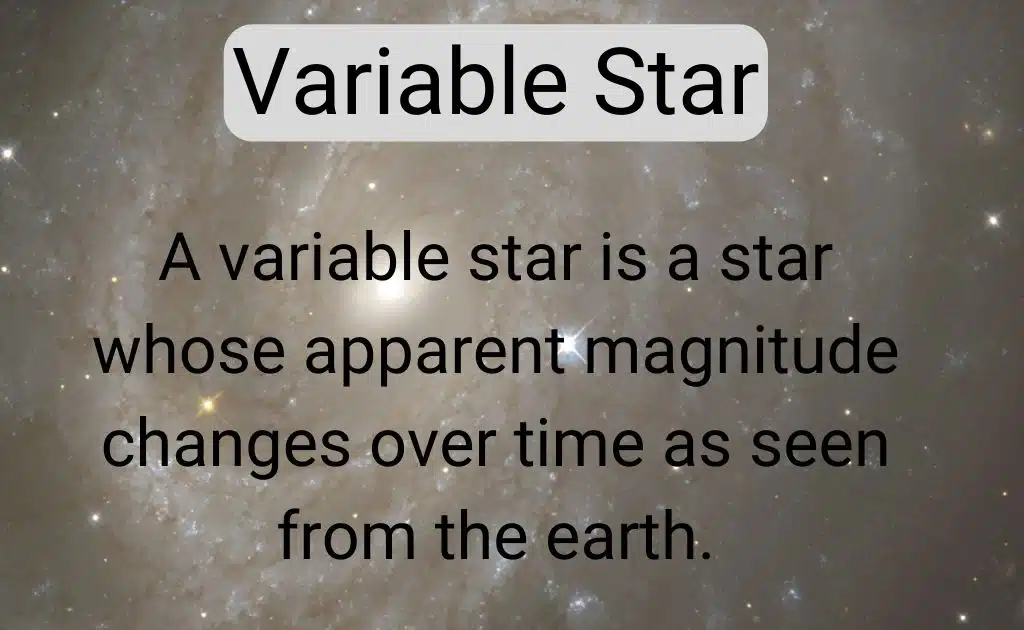Variable Star-Definition, Types, And Observation
There are a huge amount of stars in our solar system. A variable star is a star whose apparent magnitude changes over time as seen from the earth.
Variable Star
The stars that change brightness are called variable stars. The change can be as little as a thousandth of a magnitude to as much as twenty magnitudes over a period of a fraction of a second to years. Almost 150,000 variable stars have been known and documented, and as many as thousands more are thought to be variable.

Variable stars can change in brightness due to several reasons. For example, pulsating variables shrank and swell due to internal forces. A star dims during its orbit around its companion and then brightens again when the companion moves away from it.
Variable Star has variable brightness. Since a long time ago, amateurs have contributed to astronomy by maintaining records of the brightness of variable stars in their backyards. Variable stars are referred to as variable stars if the magnitude of the star changes from our perspective.
It can take years or even a fraction of a second for these changes to happen, but it can range from the one-thousandth value of the magnitude to over 20 times the brightness of the star. Variable stars, their types, changes in brightness, and their observation are all covered in this article.
There is a strong correlation between the star’s period and the star’s intrinsic brightness. Predicting the absolute magnitude of a cepheid variable star can be done by measuring the time taken to rhythmically change the brightness of a star.
The larger radius leads eventually to larger surface areas for the cepheid variable stars. The cycle of pulsation begins when the pressure towards the outside is greater than the force on the ground. The inverse square law causes the luminosity of the stars to get dimmer. Calculating the distance towards the stars is done by comparing this luminosity with the predicted luminosity of the stars.
Types of Variable Star
The variable star is classified into two categories.
- Intrinsic variable star
- Extrinsic variable star
Intrinsic variable star
Variable stars have their own output of radiant energy that can vary with time. The variables pulse rhythmically in brightness and size when they expand and contract. An intrinsic variable star is further divided into three categories.
- Explosive variables
- Pulsating variables
- Eruptive variables
Extrinsic variable star
The stars that have changes in brightness due to external stellar properties are referred to as extrinsic variable stars. They are categorized into two different categories.
- Eclipsing binaries
- Rotating stars
Observation of variable star
It is possible for anyone to be a star observer. You need a pair of binoculars, a Variable star chart, some basic instructions, and a little patience to begin observing. It becomes easier when there is time.
Variable star-gazers get so familiar with the procedures that they cover dozens of stars a night without the help of charts.
Related FAQS
What are two types of variable stars?
There are two types of variable stars: intrinsic variables, whose luminosity actually changes, and extrinsic variables, whose apparent changes in brightness are due to the amount of light that can reach Earth. The star periodically swells and shrinks.
What causes a variable star?
Variable stars are classified according to whether the variability is caused by physical changes like pulsation or eruption in the star or stellar system or by the eclipse of one star by another.
Is a supernova a variable star?
nova and supernova stars are the variable stars that are the most popular with the public. They are easy to see without a telescope if they become bright enough to be seen.
Are variable stars rare?
Variable stars are not rare. If the light from the Earth changes in brightness, the star is classified as a variable star. Variable stars are known to dim and then come back up again.







Leave a Reply